warning light NISSAN ROGUE 2021 Owner´s Manual
[x] Cancel search | Manufacturer: NISSAN, Model Year: 2021, Model line: ROGUE, Model: NISSAN ROGUE 2021Pages: 556, PDF Size: 2.7 MB
Page 66 of 556

1-46Safety — Seats, seat belts and supplemental restraint system
PRECAUTIONS ON SRS
This SRS section contains important in-
formation concerning the following sys-
tems:
.Driver and front passenger supple-
mental front-impact air bag (NISSAN
Advanced Air Bag System)
. Driver and front passenger supple-
mental knee air bag
. Front seat-mounted side-impact sup-
plemental air bag
. Rear outboard seat-mounted side-
impact supplemental air bag
. Front central seat-mounted side-im-
pact supplemental air bag (if so
equipped)
. Roof-mounted curtain side-impact
and rollover supplemental air bag
. Seat belt with pretensioner (front and
rear outboard seats)
Supplemental front-impact air bag sys-
tem: The NISSAN Advanced Air Bag Sys-
tem can help cushion the impact force to
the head and chest of the driver and front
passenger in certain frontal collisions.
Driver and front passenger supplemen-
tal knee air bag system: This system can
help cushion the impact force to the
driver’s and front passenger’s knees in
certain collisions. Front seat-mounted side-impact sup-
plemental air bag system:This system
can help cushion the impact force to the
chest and pelvic area of the driver and
front passenger in certain side impact
collisions. The side air bag is designed to
inflate on the side where the vehicle is
impacted.
Rear outboard seat-mounted side-im-
pact supplemental air bag system:
This
system can help cushion the impact force
to the chest and pelvic area of the rear
outboard seat passengers in certain side-
impact collisions. The side air bags are
designed to inflate on the side where the
vehicle is impacted.
Front central seat-mounted side-im-
pact supplemental air bag (if so
equipped): This system can help cushion
the impact force to the head area of the
driver and front passenger in certain side-
impact collisions. The front central side-
impact air bag is designed to inflate in the
front central area where the vehicle is
impacted.
Roof-mounted curtain side-impact and
rollover supplemental air bag system:
This system can help cushion the impact
force to the heads of occupants in front
and rear outboard seating positions in
certain side impact or rollover collisions.
In a side-impact, the curtain air bags are designed to inflate on the side where the
vehicle is impacted. In a rollover, the
curtain air bags on both sides are de-
signed to inflate. Under both side-impact
and rollover situations, the curtain air
bags will remain inflated for a short
period of time.
These supplemental restraint systems are
designed to
supplement the crash pro-
tection provided by the driver, passenger
and rear outboard seat belts and are not
a substitute for them. Seat belts should
always be correctly worn and the occu-
pant seated a suitable distance away
from the steering wheel, instrument pa-
nel and door finishers. (See “Seat belts”
(P.1-13) for instructions and precautions
on seat belt usage.)
The supplemental air bags operate only
when the ignition switch is in the ON
position.
After the ignition is placed in the ON
position, the supplemental air bag
warning light illuminates. The supple-
mental air bag warning light will turn
off after about 7 seconds if the systems
are operational.
SUPPLEMENTAL RESTRAINT SYSTEM (SRS)
Page 67 of 556

SSS0131
SSS0132
WARNING
.The front air bags ordinarily will
not inflate in the event of a side
impact, rear impact, rollover, or
lower severity frontal collision.
Always wear your seat belts to
help reduce the risk or severity of
injury in various kinds of acci-
dents.
. The front passenger air bag and
passenger knee air bag will not
inflate if the front passenger air
bag status light is lit. See “Front
passenger air bag and status
light” (P.1-54).
. The seat belts and the front air
bags are most effective when you
are sitting well back and upright
in the seat with both feet on the
floor. The front air bags inflate
with great force. Even with the
NISSAN Advanced Air Bag System,
if you are unrestrained, leaning
forward, sitting sideways or out
of position in any way, you are at
greater risk of injury or death in a
crash. You may also receive ser-
ious or fatal injuries from the
front air bag if you are up against
it when it inflates. Always sit back
Safety — Seats, seat belts and supplemental restraint system1-47
Page 73 of 556
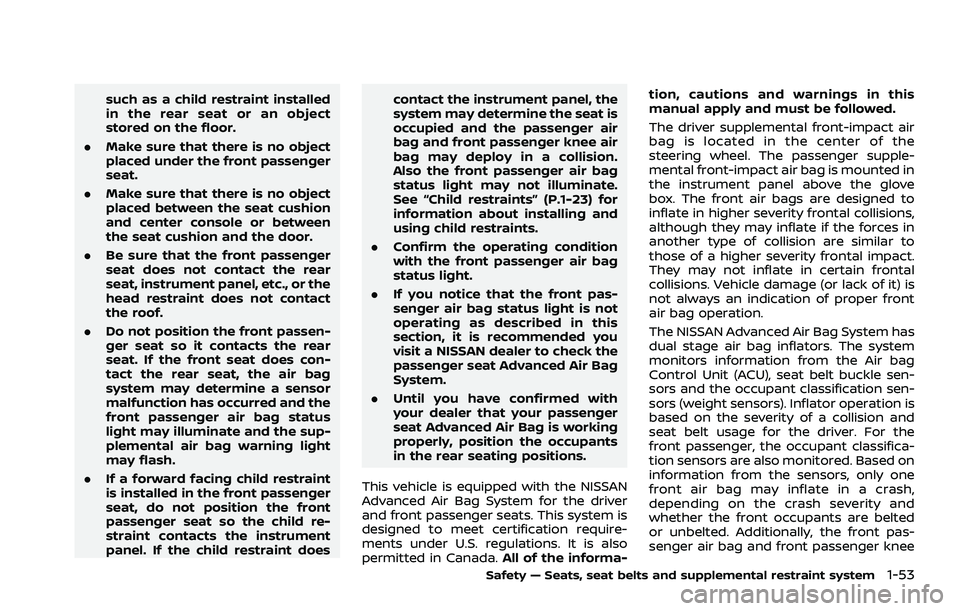
such as a child restraint installed
in the rear seat or an object
stored on the floor.
. Make sure that there is no object
placed under the front passenger
seat.
. Make sure that there is no object
placed between the seat cushion
and center console or between
the seat cushion and the door.
. Be sure that the front passenger
seat does not contact the rear
seat, instrument panel, etc., or the
head restraint does not contact
the roof.
. Do not position the front passen-
ger seat so it contacts the rear
seat. If the front seat does con-
tact the rear seat, the air bag
system may determine a sensor
malfunction has occurred and the
front passenger air bag status
light may illuminate and the sup-
plemental air bag warning light
may flash.
. If a forward facing child restraint
is installed in the front passenger
seat, do not position the front
passenger seat so the child re-
straint contacts the instrument
panel. If the child restraint does contact the instrument panel, the
system may determine the seat is
occupied and the passenger air
bag and front passenger knee air
bag may deploy in a collision.
Also the front passenger air bag
status light may not illuminate.
See “Child restraints” (P.1-23) for
information about installing and
using child restraints.
. Confirm the operating condition
with the front passenger air bag
status light.
. If you notice that the front pas-
senger air bag status light is not
operating as described in this
section, it is recommended you
visit a NISSAN dealer to check the
passenger seat Advanced Air Bag
System.
. Until you have confirmed with
your dealer that your passenger
seat Advanced Air Bag is working
properly, position the occupants
in the rear seating positions.
This vehicle is equipped with the NISSAN
Advanced Air Bag System for the driver
and front passenger seats. This system is
designed to meet certification require-
ments under U.S. regulations. It is also
permitted in Canada. All of the informa- tion, cautions and warnings in this
manual apply and must be followed.
The driver supplemental front-impact air
bag is located in the center of the
steering wheel. The passenger supple-
mental front-impact air bag is mounted in
the instrument panel above the glove
box. The front air bags are designed to
inflate in higher severity frontal collisions,
although they may inflate if the forces in
another type of collision are similar to
those of a higher severity frontal impact.
They may not inflate in certain frontal
collisions. Vehicle damage (or lack of it) is
not always an indication of proper front
air bag operation.
The NISSAN Advanced Air Bag System has
dual stage air bag inflators. The system
monitors information from the Air bag
Control Unit (ACU), seat belt buckle sen-
sors and the occupant classification sen-
sors (weight sensors). Inflator operation is
based on the severity of a collision and
seat belt usage for the driver. For the
front passenger, the occupant classifica-
tion sensors are also monitored. Based on
information from the sensors, only one
front air bag may inflate in a crash,
depending on the crash severity and
whether the front occupants are belted
or unbelted. Additionally, the front pas-
senger air bag and front passenger knee
Safety — Seats, seat belts and supplemental restraint system1-53
Page 74 of 556
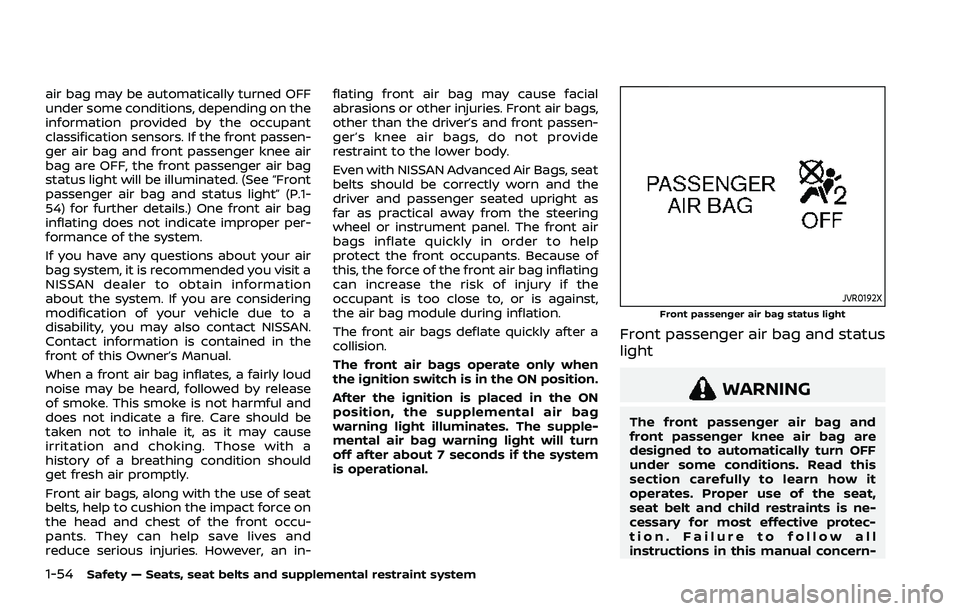
1-54Safety — Seats, seat belts and supplemental restraint system
air bag may be automatically turned OFF
under some conditions, depending on the
information provided by the occupant
classification sensors. If the front passen-
ger air bag and front passenger knee air
bag are OFF, the front passenger air bag
status light will be illuminated. (See “Front
passenger air bag and status light” (P.1-
54) for further details.) One front air bag
inflating does not indicate improper per-
formance of the system.
If you have any questions about your air
bag system, it is recommended you visit a
NISSAN dealer to obtain information
about the system. If you are considering
modification of your vehicle due to a
disability, you may also contact NISSAN.
Contact information is contained in the
front of this Owner’s Manual.
When a front air bag inflates, a fairly loud
noise may be heard, followed by release
of smoke. This smoke is not harmful and
does not indicate a fire. Care should be
taken not to inhale it, as it may cause
irritation and choking. Those with a
history of a breathing condition should
get fresh air promptly.
Front air bags, along with the use of seat
belts, help to cushion the impact force on
the head and chest of the front occu-
pants. They can help save lives and
reduce serious injuries. However, an in-flating front air bag may cause facial
abrasions or other injuries. Front air bags,
other than the driver’s and front passen-
ger’s knee air bags, do not provide
restraint to the lower body.
Even with NISSAN Advanced Air Bags, seat
belts should be correctly worn and the
driver and passenger seated upright as
far as practical away from the steering
wheel or instrument panel. The front air
bags inflate quickly in order to help
protect the front occupants. Because of
this, the force of the front air bag inflating
can increase the risk of injury if the
occupant is too close to, or is against,
the air bag module during inflation.
The front air bags deflate quickly after a
collision.
The front air bags operate only when
the ignition switch is in the ON position.
After the ignition is placed in the ON
position, the supplemental air bag
warning light illuminates. The supple-
mental air bag warning light will turn
off after about 7 seconds if the system
is operational.
JVR0192XFront passenger air bag status light
Front passenger air bag and status
light
WARNING
The front passenger air bag and
front passenger knee air bag are
designed to automatically turn OFF
under some conditions. Read this
section carefully to learn how it
operates. Proper use of the seat,
seat belt and child restraints is ne-
cessary for most effective protec-
tion. Failure to follow all
instructions in this manual concern-
Page 78 of 556
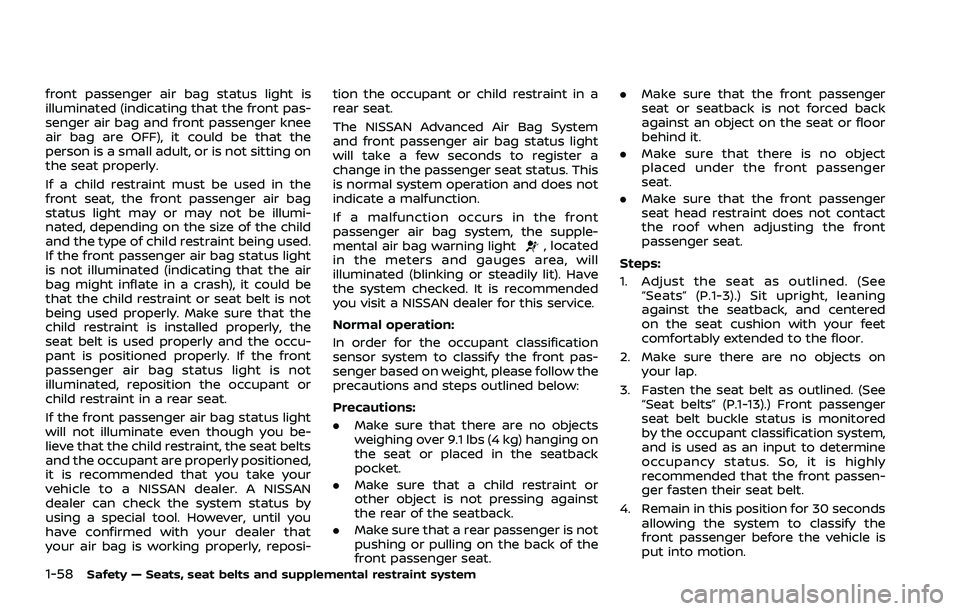
1-58Safety — Seats, seat belts and supplemental restraint system
front passenger air bag status light is
illuminated (indicating that the front pas-
senger air bag and front passenger knee
air bag are OFF), it could be that the
person is a small adult, or is not sitting on
the seat properly.
If a child restraint must be used in the
front seat, the front passenger air bag
status light may or may not be illumi-
nated, depending on the size of the child
and the type of child restraint being used.
If the front passenger air bag status light
is not illuminated (indicating that the air
bag might inflate in a crash), it could be
that the child restraint or seat belt is not
being used properly. Make sure that the
child restraint is installed properly, the
seat belt is used properly and the occu-
pant is positioned properly. If the front
passenger air bag status light is not
illuminated, reposition the occupant or
child restraint in a rear seat.
If the front passenger air bag status light
will not illuminate even though you be-
lieve that the child restraint, the seat belts
and the occupant are properly positioned,
it is recommended that you take your
vehicle to a NISSAN dealer. A NISSAN
dealer can check the system status by
using a special tool. However, until you
have confirmed with your dealer that
your air bag is working properly, reposi-tion the occupant or child restraint in a
rear seat.
The NISSAN Advanced Air Bag System
and front passenger air bag status light
will take a few seconds to register a
change in the passenger seat status. This
is normal system operation and does not
indicate a malfunction.
If a malfunction occurs in the front
passenger air bag system, the supple-
mental air bag warning light
, located
in the meters and gauges area, will
illuminated (blinking or steadily lit). Have
the system checked. It is recommended
you visit a NISSAN dealer for this service.
Normal operation:
In order for the occupant classification
sensor system to classify the front pas-
senger based on weight, please follow the
precautions and steps outlined below:
Precautions:
. Make sure that there are no objects
weighing over 9.1 lbs (4 kg) hanging on
the seat or placed in the seatback
pocket.
. Make sure that a child restraint or
other object is not pressing against
the rear of the seatback.
. Make sure that a rear passenger is not
pushing or pulling on the back of the
front passenger seat. .
Make sure that the front passenger
seat or seatback is not forced back
against an object on the seat or floor
behind it.
. Make sure that there is no object
placed under the front passenger
seat.
. Make sure that the front passenger
seat head restraint does not contact
the roof when adjusting the front
passenger seat.
Steps:
1. Adjust the seat as outlined. (See “Seats” (P.1-3).) Sit upright, leaning
against the seatback, and centered
on the seat cushion with your feet
comfortably extended to the floor.
2. Make sure there are no objects on your lap.
3. Fasten the seat belt as outlined. (See “Seat belts” (P.1-13).) Front passenger
seat belt buckle status is monitored
by the occupant classification system,
and is used as an input to determine
occupancy status. So, it is highly
recommended that the front passen-
ger fasten their seat belt.
4. Remain in this position for 30 seconds allowing the system to classify the
front passenger before the vehicle is
put into motion.
Page 80 of 556
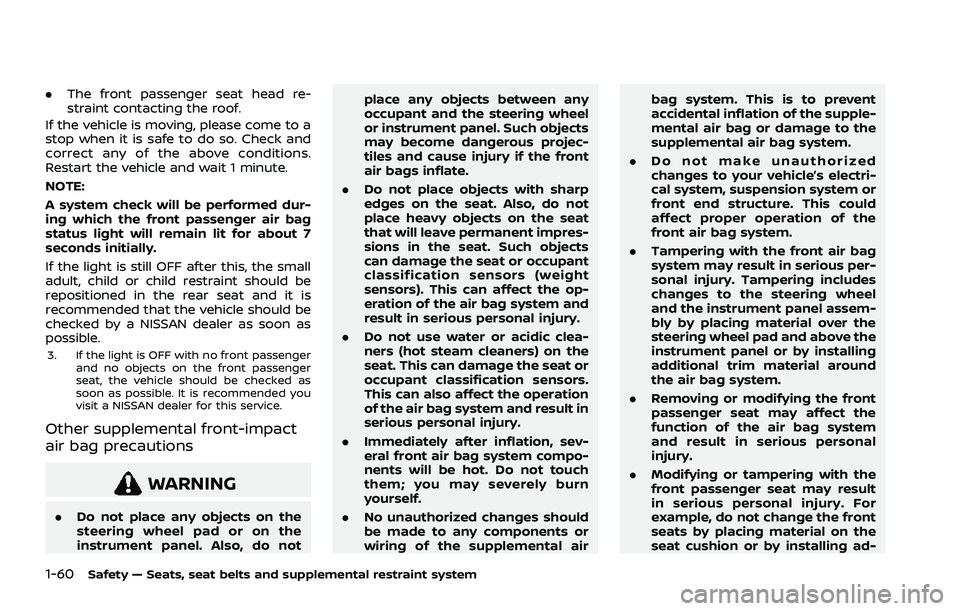
1-60Safety — Seats, seat belts and supplemental restraint system
.The front passenger seat head re-
straint contacting the roof.
If the vehicle is moving, please come to a
stop when it is safe to do so. Check and
correct any of the above conditions.
Restart the vehicle and wait 1 minute.
NOTE:
A system check will be performed dur-
ing which the front passenger air bag
status light will remain lit for about 7
seconds initially.
If the light is still OFF after this, the small
adult, child or child restraint should be
repositioned in the rear seat and it is
recommended that the vehicle should be
checked by a NISSAN dealer as soon as
possible.
3. If the light is OFF with no front passenger and no objects on the front passenger
seat, the vehicle should be checked as
soon as possible. It is recommended you
visit a NISSAN dealer for this service.
Other supplemental front-impact
air bag precautions
WARNING
.Do not place any objects on the
steering wheel pad or on the
instrument panel. Also, do not place any objects between any
occupant and the steering wheel
or instrument panel. Such objects
may become dangerous projec-
tiles and cause injury if the front
air bags inflate.
. Do not place objects with sharp
edges on the seat. Also, do not
place heavy objects on the seat
that will leave permanent impres-
sions in the seat. Such objects
can damage the seat or occupant
classification sensors (weight
sensors). This can affect the op-
eration of the air bag system and
result in serious personal injury.
. Do not use water or acidic clea-
ners (hot steam cleaners) on the
seat. This can damage the seat or
occupant classification sensors.
This can also affect the operation
of the air bag system and result in
serious personal injury.
. Immediately after inflation, sev-
eral front air bag system compo-
nents will be hot. Do not touch
them; you may severely burn
yourself.
. No unauthorized changes should
be made to any components or
wiring of the supplemental air bag system. This is to prevent
accidental inflation of the supple-
mental air bag or damage to the
supplemental air bag system.
. Do not make unauthorized
changes to your vehicle’s electri-
cal system, suspension system or
front end structure. This could
affect proper operation of the
front air bag system.
. Tampering with the front air bag
system may result in serious per-
sonal injury. Tampering includes
changes to the steering wheel
and the instrument panel assem-
bly by placing material over the
steering wheel pad and above the
instrument panel or by installing
additional trim material around
the air bag system.
. Removing or modifying the front
passenger seat may affect the
function of the air bag system
and result in serious personal
injury.
. Modifying or tampering with the
front passenger seat may result
in serious personal injury. For
example, do not change the front
seats by placing material on the
seat cushion or by installing ad-
Page 82 of 556

1-62Safety — Seats, seat belts and supplemental restraint system
WAB0048XFront passenger’s side
Vehicle damage (or lack of it) is not
always an indication of proper knee air
bag operation.
When the knee air bag inflates, a fairly
loud noise may be heard, followed by
release of smoke. This smoke is not
harmful and does not indicate a fire. Care
should be taken not to inhale it, as it may
cause irritation and choking. Those with a
history of a breathing condition should
get fresh air promptly.
The knee air bag helps to cushion the
impact force on the knees of the driver
and front passenger. It can help reduce
serious injuries. However, an inflating
knee air bag may cause abrasions orother injuries. The knee air bag provides
restraint to the lower body.
The knee air bag inflates quickly in order
to help protect the occupants. Because of
this, the force of the knee air bag inflating
can increase the risk of injury if the
occupant is too close to, or is against,
this air bag module during inflation. The
knee air bag will deflate quickly after the
collision is over OR the knee air bag will
remain inflated for a short time.
The knee air bag operates only when
the ignition switch is placed in the ON
position.
After placing the ignition switch in the
ON position, the supplemental air bag
warning light illuminates. The supple-
mental air bag warning light will turn
off after about 7 seconds if the system
is operational.
WARNING
.
Do not place any objects between
the knee bolster and the driver’s
or front passenger’s seat. Such
objects may become dangerous
projectiles and cause injury if a
knee air bag inflates. .
Right after inflation, the knee air
bag system components will be
hot. Do not touch them; you may
severely burn yourself.
. No unauthorized changes should
be made to any components or
wiring of the knee air bag system.
This is to prevent damage to or
accidental inflation of the knee
air bag system.
. Do not make unauthorized
changes to your vehicle’s electri-
cal system or suspension system.
This could affect proper opera-
tion of the knee air bag system.
. Tampering with the knee air bag
system may result in serious per-
sonal injury. For example, do not
change the driver or front pas-
senger knee bolster or install
additional trim material around
the knee air bag.
. It is recommended that you visit a
NISSAN dealer for work on and
around the knee air bag. It is also
recommended that you visit a
NISSAN dealer for installation of
electrical equipment. The SRS
wiring harnesses* should not be
modified or disconnected. Un-
authorized electrical test equip-
Page 84 of 556
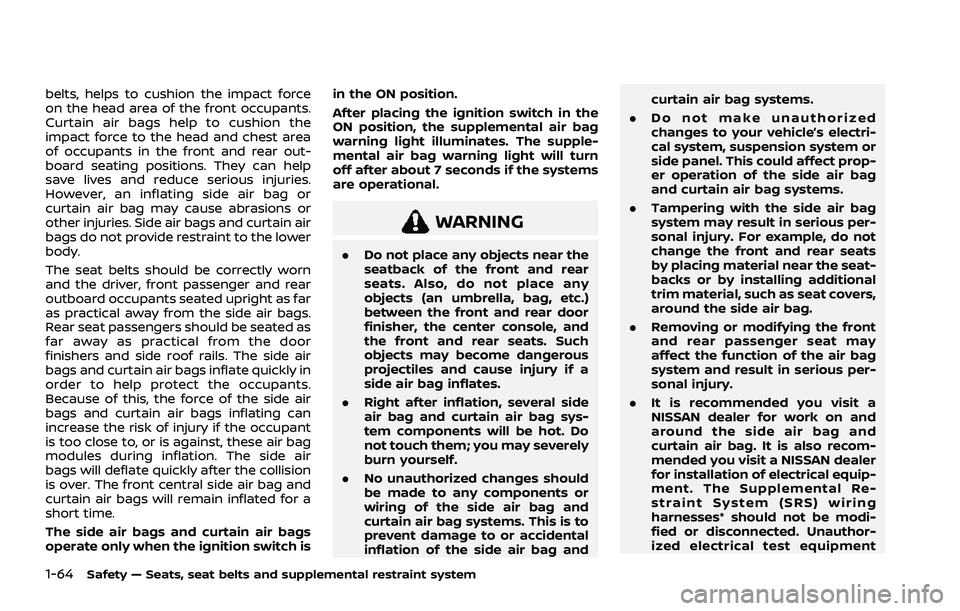
1-64Safety — Seats, seat belts and supplemental restraint system
belts, helps to cushion the impact force
on the head area of the front occupants.
Curtain air bags help to cushion the
impact force to the head and chest area
of occupants in the front and rear out-
board seating positions. They can help
save lives and reduce serious injuries.
However, an inflating side air bag or
curtain air bag may cause abrasions or
other injuries. Side air bags and curtain air
bags do not provide restraint to the lower
body.
The seat belts should be correctly worn
and the driver, front passenger and rear
outboard occupants seated upright as far
as practical away from the side air bags.
Rear seat passengers should be seated as
far away as practical from the door
finishers and side roof rails. The side air
bags and curtain air bags inflate quickly in
order to help protect the occupants.
Because of this, the force of the side air
bags and curtain air bags inflating can
increase the risk of injury if the occupant
is too close to, or is against, these air bag
modules during inflation. The side air
bags will deflate quickly after the collision
is over. The front central side air bag and
curtain air bags will remain inflated for a
short time.
The side air bags and curtain air bags
operate only when the ignition switch isin the ON position.
After placing the ignition switch in the
ON position, the supplemental air bag
warning light illuminates. The supple-
mental air bag warning light will turn
off after about 7 seconds if the systems
are operational.
WARNING
.
Do not place any objects near the
seatback of the front and rear
seats. Also, do not place any
objects (an umbrella, bag, etc.)
between the front and rear door
finisher, the center console, and
the front and rear seats. Such
objects may become dangerous
projectiles and cause injury if a
side air bag inflates.
. Right after inflation, several side
air bag and curtain air bag sys-
tem components will be hot. Do
not touch them; you may severely
burn yourself.
. No unauthorized changes should
be made to any components or
wiring of the side air bag and
curtain air bag systems. This is to
prevent damage to or accidental
inflation of the side air bag and curtain air bag systems.
. Do not make unauthorized
changes to your vehicle’s electri-
cal system, suspension system or
side panel. This could affect prop-
er operation of the side air bag
and curtain air bag systems.
. Tampering with the side air bag
system may result in serious per-
sonal injury. For example, do not
change the front and rear seats
by placing material near the seat-
backs or by installing additional
trim material, such as seat covers,
around the side air bag.
. Removing or modifying the front
and rear passenger seat may
affect the function of the air bag
system and result in serious per-
sonal injury.
. It is recommended you visit a
NISSAN dealer for work on and
around the side air bag and
curtain air bag. It is also recom-
mended you visit a NISSAN dealer
for installation of electrical equip-
ment. The Supplemental Re-
straint System (SRS) wiring
harnesses* should not be modi-
fied or disconnected. Unauthor-
ized electrical test equipment
Page 85 of 556

and probing devices should not
be used on the side air bag or
curtain air bag systems.
*The SRS wiring harness connectors are
yellow and orange for easy identifica-
tion.
When selling your vehicle, we request that
you inform the buyer about the side air
bag and curtain air bag systems and
guide the buyer to the appropriate sec-
tions in this Owner’s Manual.
SEAT BELTS WITH PRETENSIONERS
(front and rear outboard seats)
WARNING
. The pretensioners cannot be re-
used after activation. They must
be replaced together with the
retractor and buckle as a unit.
. If the vehicle becomes involved in
a collision but a pretensioner is
not activated, be sure to have the
pretensioner system checked
and, if necessary, repaired. It is
recommended you visit a NISSAN
dealer for this service.
. No unauthorized changes should
be made to any components or wiring of the pretensioner sys-
tem. This is to prevent damage to
or accidental activation of the
pretensioners. Tampering with
the pretensioner system may re-
sult in serious personal injury.
. It is recommended you visit a
NISSAN dealer for work on and
around the pretensioner system.
It is also recommended you visit a
NISSAN dealer for installation of
electrical equipment. Unauthor-
ized electrical test equipment
and probing devices should not
be used on the pretensioner sys-
tem.
. If you need to dispose of a pre-
tensioner or scrap the vehicle, it is
recommended you visit a NISSAN
dealer for this service. Correct
pretensioner disposal procedures
are set forth in the appropriate
NISSAN Service Manual. Incorrect
disposal procedures could cause
personal injury.
The pretensioner system may activate
with the supplemental air bag system in
certain types of collisions. Working with
the seat belt retractor, it helps tighten the
seat belt when the vehicle becomes
involved in certain types of collisions, helping to restrain front and rear out-
board seat occupants.
The pretensioner is encased with the seat
belt retractor. These seat belts are used
the same way as conventional seat belts.
When a pretensioner activates, smoke is
released and a loud noise may be heard.
The smoke is not harmful and does not
indicate a fire. Care should be taken not
to inhale it, as it may cause irritation and
choking. Those with a history of a breath-
ing condition should get fresh air
promptly.
After pretensioner activation, load limiters
allow the seat belt to release webbing (if
necessary) to reduce forces against the
chest.
The supplemental air bag warning lightis used to indicate malfunctions in
the pretensioner system. See “Supple-
mental air bag warning light” (P.1-66). If
the operation of the supplemental air bag
warning light indicates there is a mal-
function, have the system checked. It is
recommended you visit a NISSAN dealer
for this service.
When selling your vehicle, we request that
you inform the buyer about the preten-
sioner system and guide the buyer to the
appropriate sections in this Owner’s Man-
ual.
Safety — Seats, seat belts and supplemental restraint system1-65
Page 86 of 556
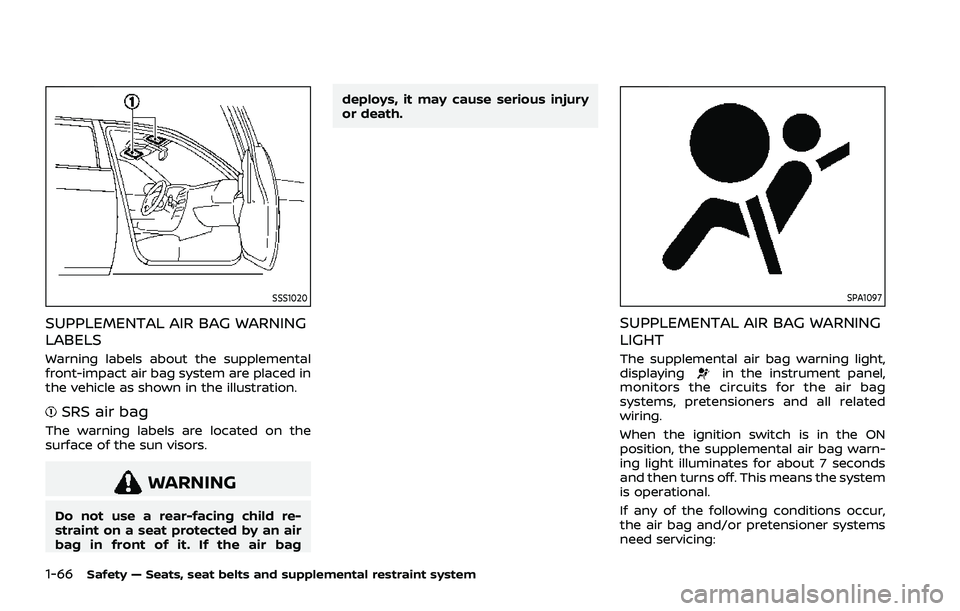
1-66Safety — Seats, seat belts and supplemental restraint system
SSS1020
SUPPLEMENTAL AIR BAG WARNING
LABELS
Warning labels about the supplemental
front-impact air bag system are placed in
the vehicle as shown in the illustration.
SRS air bag
The warning labels are located on the
surface of the sun visors.
WARNING
Do not use a rear-facing child re-
straint on a seat protected by an air
bag in front of it. If the air bagdeploys, it may cause serious injury
or death.
SPA1097
SUPPLEMENTAL AIR BAG WARNING
LIGHT
The supplemental air bag warning light,
displayingin the instrument panel,
monitors the circuits for the air bag
systems, pretensioners and all related
wiring.
When the ignition switch is in the ON
position, the supplemental air bag warn-
ing light illuminates for about 7 seconds
and then turns off. This means the system
is operational.
If any of the following conditions occur,
the air bag and/or pretensioner systems
need servicing: